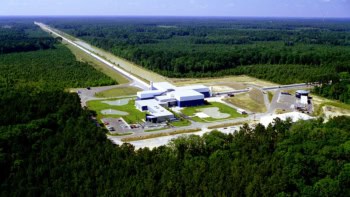Richard de Grijs reviews From the Great Wall to the Great Collider: China and the Quest to Uncover the Inner Workings of the Universe by Steve Nadis and Shing-Tung Yau

On 4 July 2012 the world took note of particle physics. The announcement that the existence of the Higgs boson had finally been confirmed (at the prerequisite “5 sigma” level of significance) by researchers working on the Large Hadron Collider (LHC) at CERN was met with cheers and heartfelt congratulations, both inside the European particle-physics laboratory and out. This was a momentous result, given that the Higgs boson and its associated field represent an essential cornerstone of the Standard Model of particle physics.
In their book From the Great Wall to the Great Collider, science journalist Steve Nadis and Harvard physicist Shing-Tung Yau embrace that momentum and the community’s great excitement to make a compelling case for investment in the next-generation particle accelerator. While construction of the LHC was a “no-lose” project (because the machine would either find evidence of the Higgs’ existence, or rule it out and force physicists to develop new theories), the arguments in support of an even bigger – and more costly – collider are more subtle. Now that the Higgs has been found, the foremost mysteries on particle physicists’ minds include the nature of the elusive “dark matter” and the question of why the universe contains vastly more matter than antimatter – a conundrum known as charge–parity violation. In the grand scheme of our understanding of the fundamental basis of nature, these questions are every bit as exciting as the Higgs, and answering them may, similarly, require a mammoth new machine.
In their book, Nadis and Yau attempt to merge two stories into one, providing both a fairly detailed account of the history of particle physics and a description of how particle physicists all over the world (not just in China) hope to embark on the next big project in our quest to uncover the remaining secrets of the universe. Using the Great Wall of China as a metaphor, they paint a picture of China’s scientific development that shows a nation full of ambition and aspirations, one that is rapidly catching up with the international community and taking on a leading role where possible. Whereas the Great Wall was constructed to keep foreign invaders away from the Chinese heartland, the proposed “Great Collider” would embrace the international scientific community and propel Chinese science to a leading role on the world’s stage.
Having recently re-read Dennis Overbye’s brilliantly written history of cosmology and particle physics, Lonely Hearts of the Cosmos, I was keen to learn about the latest developments in this fast-moving field and read first-hand where we might be going from here. As this book is aimed at a general readership, the authors clearly felt that they had to provide a detailed background to the field of particle physics, as well as a proper international context. This is where I got confused. First, as a professional physicist, I found their introduction to particle physics tedious and scholarly, requiring a significant level of prior knowledge. A concise summary of definitions and particle types would have been useful indeed. The narrative reads like a scientific manuscript that has been toned down somewhat to the level of us mere mortals. I am afraid that this feels a little forced. Certainly, it is a far cry from Overbye’s eloquence, and the authors’ composition falls into many of the pitfalls outlined in Steven Pinker’s The Sense of Style – arguably the current best style guide for aspiring authors.
All of this genuine excitement about particle physics is wrapped in an overtly political message to Chinese policy-makers
This leads me to wonder who the authors considered as their intended audience. On the one hand, the introduction to particle physics appears aimed at undergraduate physics students. On the other, the excitement of the Higgs discovery comes across palpably, and so does the scientists’ ambition to uncover the remaining secrets of the universe by embarking on an even bigger adventure. The reader gets a great impression of where the cutting edge is in this field, where key open questions cover such diverse topics as the conditions that prevailed a mere fraction of a second after the Big Bang; whether the Standard Model is a one-size-fits-all theory or may need further and significant modifications (such as the addition of much more massive fundamental particles); and the scientific surprises and returns much higher-energy accelerators could yield. Another key question is whether multidimensionality – most notably, string theory – could overcome the so-called Higgs “mass hierarchy” problem, which is the discrepancy of 16 orders of magnitude between the mass of the Higgs (measured independently by both the ATLAS and the CMS detectors at CERN) and the Planck mass predicted by the Standard Model.
Yet all of this genuine excitement is wrapped in an overtly political message to Chinese policy-makers, suggesting that the development of a 70–100 TeV electron–positron accelerator, followed by a proton–proton collider using the same basic infrastructure, would cement China’s place in the international scientific pecking order. It is unfortunate that the authors chose to start their narrative with such a political statement in the guise of the book’s introduction, which was clearly composed after the main text had been completed. As a consequence, a number of key technical terms – symmetry, string theory, M theory – are introduced from the outset but not addressed or defined until later chapters.
Nevertheless, Nadis and Yau make a very compelling case for particle physics as a clear technology driver, one that has tremendous potential for spawning numerous (as yet unknown) spin-off applications, both technical and in terms of China’s position as a leading scientific nation. With the country’s gross domestic product robustly on the rise, China will soon overtake the US as the leading economy in the world. Its scientific workforce is incredibly keen to take on and indeed lead large international projects, a perspective broadly supported by the country’s technologically savvy leadership. Time is of the essence, however. Research and development to get a gargantuan effort such as the Circular Electron–Position Collider and its proposed successor, the Super Proton–Proton Collider, on its way towards construction and operation by the time CERN’s LHC runs out of steam must start soon. The world is looking for Chinese leadership, and this seems like an excellent opportunity to step up to the challenge. This is the key message I take away from Nadis and Yau’s plea for the world to get prepared for the next half-century of excitement in particle physics.
- 2015 International Press $29.95hb 214pp



